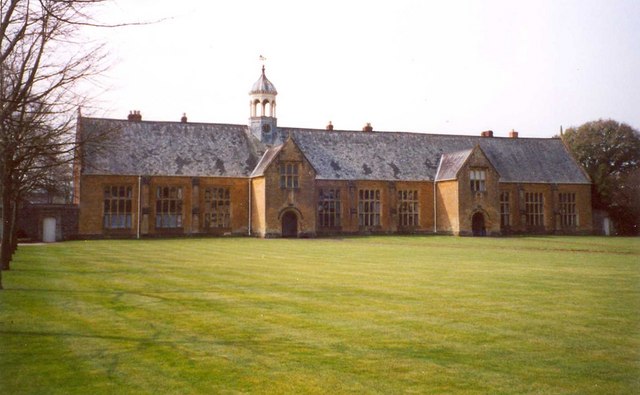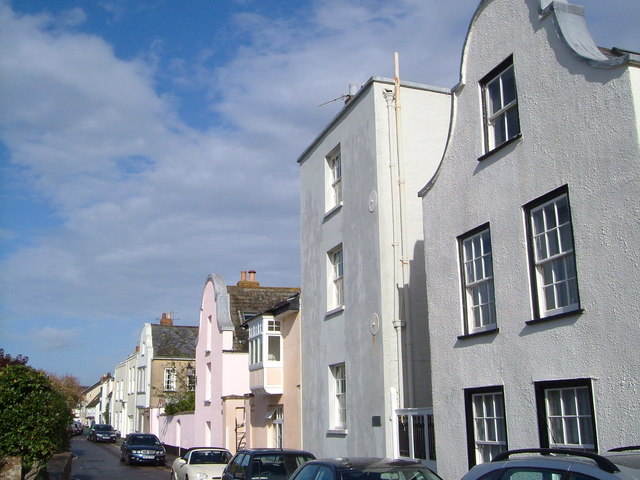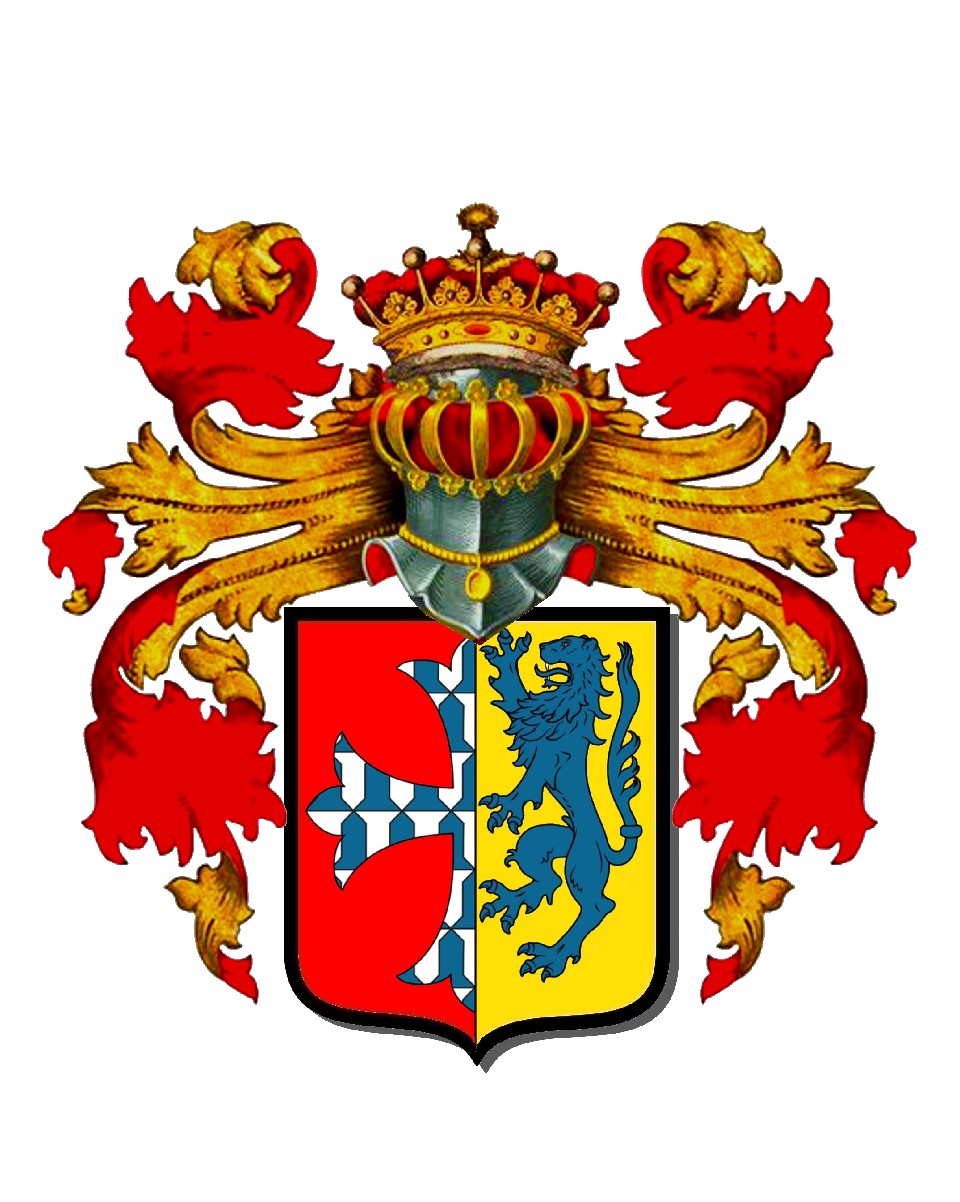|
Tiverton, Devon
Tiverton ( ) is a town and civil parish in Devon, England, and the commercial and administrative centre of the Mid Devon district. The population in 2019 was 20,587. History Early history The town's name is conjectured to derive from "Twy-ford-ton" or "Twyverton", meaning "the town on two fords", and was historically referred to as "Twyford". The town stands at the confluence of the rivers Exe and Lowman. Human occupation in the area dates back to the Stone Age, with many flint tools found in the area. An Iron Age hill fort, Cranmore Castle, stands at the top of Exeter Hill above the town, and a Roman fort or marching camp was discovered on the hillside below Knightshayes Court near Bolham, just to the north of the town. Tiverton formed part of the inheritance of Aethelweard, youngest son of King Alfred. Countess Gytha of Wessex controlled the town in 1066 and the Domesday Book indicates that William the Conqueror was its tenant-in-chief in 1086. Tiverton was also the se ... [...More Info...] [...Related Items...] OR: [Wikipedia] [Google] [Baidu] |
Tiverton Town Hall
Tiverton Town Hall is a municipal building in St Andrew Street in Tiverton, Devon, England. The structure, which was the meeting place of Tiverton Borough Council, is a Grade II listed building. History The first municipal building in Tiverton was a medieval guildhall built on the site of the old St Thomas's Chapel in around 1615. The guildhall incorporated magistrates' court facilities as well as the local gaol. Following significant population growth, in part associated with the local lacemaking industry established by John Heathcoat in the early 19th century, Tiverton became a municipal borough in 1835. In the 1860s, after finding the guildhall too small, civic leaders decided to demolish the old building and to erect a new town hall on the site. The new building was designed by Henry Lloyd in the Renaissance style, built by a former mayor of the town, Samuel Garth, in ashlar stone at a cost of £12,000 and was officially opened in May 1864. The design involved an asymmetric ... [...More Info...] [...Related Items...] OR: [Wikipedia] [Google] [Baidu] |
William The Conqueror
William I; ang, WillelmI (Bates ''William the Conqueror'' p. 33– 9 September 1087), usually known as William the Conqueror and sometimes William the Bastard, was the first House of Normandy, Norman List of English monarchs#House of Normandy, king of England, reigning from 1066 until his death in 1087. A descendant of Rollo, he was Duke of Normandy from 1035 onward. By 1060, following a long struggle to establish his throne, his hold on Normandy was secure. In 1066, following the death of Edward the Confessor, William invaded England, leading an army of Normans to victory over the Anglo-Saxons, Anglo-Saxon forces of Harold Godwinson at the Battle of Hastings, and suppressed subsequent English revolts in what has become known as the Norman Conquest. The rest of his life was marked by struggles to consolidate his hold over England and his continental lands, and by difficulties with his eldest son, Robert Curthose. William was the son of the unmarried Duke Robert I of Normandy ... [...More Info...] [...Related Items...] OR: [Wikipedia] [Google] [Baidu] |
Independent School
An independent school is independent in its finances and governance. Also known as private schools, non-governmental, privately funded, or non-state schools, they are not administered by local, state or national governments. In British English, an independent school usually refers to a school which is endowed, i.e. held by a trust, charity, or foundation, while a private school is one that is privately owned. Independent schools are usually not dependent upon national or local government to finance their financial endowment. They typically have a board of governors who are elected independently of government and have a system of governance that ensures their independent operation. Children who attend such schools may be there because they (or their parents) are dissatisfied with government-funded schools (in UK state schools) in their area. They may be selected for their academic prowess, prowess in other fields, or sometimes their religious background. Private schools r ... [...More Info...] [...Related Items...] OR: [Wikipedia] [Google] [Baidu] |
Blundell's School
Blundell's School is a co-educational day and boarding independent school in the English public school tradition, located in Tiverton, Devon. It was founded in 1604 under the will of Peter Blundell, one of the richest men in England at the time, and moved to its present site on the outskirts of the town in 1882. While the full boarding fees are £38,985 per year, the school offers several scholarships and bursaries, and provides flexi-boarding. The school has 360 boys and 225 girls, including 117 boys and 85 girls in the Sixth Form, and is a member of the Headmasters' and Headmistresses' Conference. The ''Good Schools Guide'' calls Blundell's a "distinguished rural school of ancient lineage". History Peter Blundell, one of the wealthiest merchants of Elizabethan England, died in 1601, having made his fortune principally in the cloth industry. His will set aside considerable money and land to establish a school in his home town "to maintain sound learning and true religion". ... [...More Info...] [...Related Items...] OR: [Wikipedia] [Google] [Baidu] |
Peter Blundell
Peter Blundell (c. 1520–1601) was a prosperous clothier, trading between Tiverton and London. He died in April 1601, never having married and with no known issue. On his death, he left over £32,000 cash to fellow clothiers and their families, his employees, created several charitable trusts, and gave £2400 to build Blundell's School, to be a free grammar school. Blundell also left £2000 in his will for the endowment of six scholars from The School in Divinity at the Universities of Oxford and Cambridge; arrangements were made for Blundell Scholars to enter Balliol and Sidney Sussex colleges respectively. He was buried on 9 May 1601 at St Michael Paternoster Royal in London. Blundell Park, the ground of Grimsby Town Football Club Grimsby Town Football Club is a professional association football, football club based in Cleethorpes, North East Lincolnshire, England, that in the 2022–23 season will compete in , the fourth tier of the English football league system, ... [...More Info...] [...Related Items...] OR: [Wikipedia] [Google] [Baidu] |
St Peter's Church, Tiverton
St Peter's Church, Tiverton is a Grade I listed parish church in the Church of England in Tiverton, Devon. History The church dates from 1073. Several restorations have been undertaken, in 1825–1829 by G.A. Boyce, and in 1853–1856 by Edward Ashworth of Exeter. The church was described by Nikolaus Pevsner as "a gorgeously ostentatious display of civic pride". The building was designated as Grade I listed in 1952. Organ The earliest records of organs in the church are in 1524, but the current organ dates from 1696 by Christian Smith. There have been subsequent modifications by Andrews and Shirland (1711), John Snetzler (1770), Henry Willis (1867) and Noel Mander (1967). A specification of the organ can be found on the National Pipe Organ Register. The church is noted as being the location of the first performance of Mendelssohn's "Wedding March" which was performed by Samuel Reay Samuel Reay (17 March 1828 – 21 July 1905) was an organist and composer based in England. Li ... [...More Info...] [...Related Items...] OR: [Wikipedia] [Google] [Baidu] |
Perambulation Of The Town Leat
The Perambulation of the Town Leat is a traditional mediaeval custom, also known as water-bailing, that takes place in the town of Tiverton, Devon, England, once every seven years. The event commemorates and claims the gift of the town's water supply in around 1262 from Isabella, Countess of Devon. The tradition involves walking the length of the watercourse (the leat) to its source six miles away at Norwood Common. The procession starts at the Town Hall and is led by the four individuals known as "pioneers" armed with pickaxes and sledgehammers whose job it is to demolish any obstruction found in the stream. Behind the pioneers is the Bailiff of the Hundred, who carries an ancient staff of office, behind him are the "Withy-boys", drawn from Blundell's School and Tiverton High School, whose job it is to whip the stream with willow sticks – or withy A withy or withe (also willow and osier) is a strong flexible willow stem, typically used in thatching, basketmaking, garde ... [...More Info...] [...Related Items...] OR: [Wikipedia] [Google] [Baidu] |
Low Countries
The term Low Countries, also known as the Low Lands ( nl, de Lage Landen, french: les Pays-Bas, lb, déi Niddereg Lännereien) and historically called the Netherlands ( nl, de Nederlanden), Flanders, or Belgica, is a coastal lowland region in Northwestern Europe forming the lower basin of the Rhine–Meuse–Scheldt delta and consisting of three countries: Belgium, the Netherlands and Luxembourg. Geographically and historically, the area also includes parts of France and Germany such as the French Flanders and the German regions of East Frisia and Cleves. During the Middle Ages, the Low Countries were divided into numerous semi-independent principalities. Historically, the regions without access to the sea linked themselves politically and economically to those with access to form various unions of ports and hinterland, stretching inland as far as parts of the German Rhineland. Because of this, nowadays not only physically low-altitude areas, but also some hilly or elevated regi ... [...More Info...] [...Related Items...] OR: [Wikipedia] [Google] [Baidu] |
Topsham, Devon
Topsham (, also ) is a town in Devon, England, located on the east side of the River Exe, immediately north of its confluence with the River Clyst and the former's estuary, between Exeter and Exmouth. Topsham is a historic port and was designated a town by a 1300 royal charter granted by Edward I; it was formally amalgamated into the City of Exeter in 1966. The town is served by Topsham railway station, about midway on the branch line from Exeter Central to Exmouth, now called the Avocet Line; 2011 saw the 150th anniversary of the railway coming to Topsham. The electoral ward of Topsham had a population recorded at 5,519 in the 2011 census, though this ward extends further northwest and includes the east half of Countess Wear as well as the new suburb of Newcourt. History The native Celtic settlement of Topsham became the port of the Roman city of Isca Dumnoniorum (Exeter) in the first century AD, and continued to serve it until the Roman occupation of southern Britain cea ... [...More Info...] [...Related Items...] OR: [Wikipedia] [Google] [Baidu] |
Baldwin De Redvers, 6th Earl Of Devon
Baldwin de Redvers, 6th Earl of Devon (1217 – 15 February 1245), feudal baron of Plympton in Devon and Lord of the Isle of Wight, was the son of Baldwin de Redvers and Margaret FitzGerold and grandson of William de Redvers, 5th Earl of Devon. Career Because his father died at a young age it is likely that Baldwin was born posthumously. Although it is not recorded when he came of age and did homage for his lands, it is known that he was knighted by King Henry III and created 6th Earl of Devon on Christmas Day 1239 at Winchester. In 1240 he departed to the Holy Land on the Barons' Crusade with a host of crusaders led by Richard of Cornwall. Family and children In 1235 he married Amice de Clare (1220–1284), daughter of Gilbert de Clare, 4th Earl of Hertford and had the following children: # Baldwin de Redvers, 7th Earl of Devon. # Isabella de Redvers, Countess of Devon (or Isabella de Fortibus) (died 1293), married William de Forz, 4th Earl of Albemarle. After the death of ... [...More Info...] [...Related Items...] OR: [Wikipedia] [Google] [Baidu] |
Isabella De Fortibus
Isabel de Forz (July 1237 – 10 November 1293) (or Isabel de Redvers, Latinized to Isabella de Fortibus) was the eldest daughter of Baldwin de Redvers, 6th Earl of Devon (1217–1245). On the death of her brother Baldwin de Redvers, 7th Earl of Devon in 1262, without children, she inherited ''suo jure'' (in her own right) the earldom and also the feudal barony of Plympton in Devon, and the Lordship of the Isle of Wight. After the early death of her husband and her brother, before she was thirty years old, she inherited their estates and became one of the richest women in England, living mainly in Carisbrooke Castle on the Isle of Wight, which she held from the king as tenant-in-chief. She had six children, all of whom died before her. On her death bed, she was persuaded to sell the Isle of Wight to King Edward I, in a transaction that has ever since been considered questionable. Her heir to the feudal barony of Plympton was her cousin Hugh de Courtenay, 1st/9th Earl of Devon ... [...More Info...] [...Related Items...] OR: [Wikipedia] [Google] [Baidu] |
Leat
A leat (; also lete or leet, or millstream) is the name, common in the south and west of England and in Wales, for an artificial watercourse or aqueduct dug into the ground, especially one supplying water to a watermill or its mill pond. Other common uses for leats include delivery of water for hydraulic mining and mineral concentration, for irrigation, to serve a dye works or other industrial plant, and provision of drinking water to a farm or household or as a catchment cut-off to improve the yield of a reservoir. According to the ''Oxford English Dictionary'', ''leat'' is cognate with ''let'' in the sense of "allow to pass through". Other names for the same thing include ''fleam'' (probably a leat supplying water to a mill that did not have a millpool). In parts of northern England, for example around Sheffield, the equivalent word is ''goit''. In southern England, a leat used to supply water for water-meadow irrigation is often called a ''carrier'', ''top carrier'', or ' ... [...More Info...] [...Related Items...] OR: [Wikipedia] [Google] [Baidu] |










